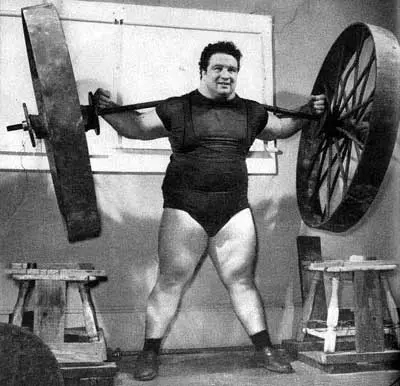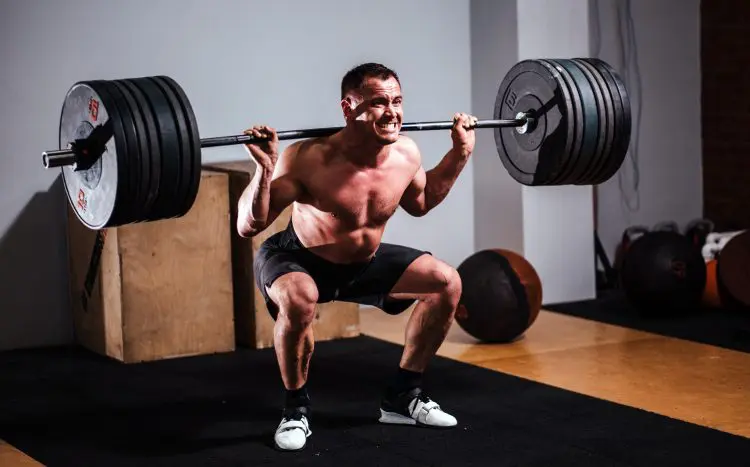When it comes to making improvements in strength, often coaches will emphasize that change takes time – and this is undoubtedly true.
However, on occasions, it may be necessary to attempt to speed up the process. This is particularly true for those who compete in strength sports like powerlifting.
If there is a competition on the horizon, powerlifters may need to increase their training frequency, volume, and intensity to ensure they are in the best condition possible to compete.
This article will look at the Smolov program which is a high-volume, block periodized training plan. Over the years, this program has been used by powerlifters to help rapidly improve their squat in the lead up to a competition.
The Origins Of The Smolov Program
As the name may suggest, this program originates from Russia. It was first publicized in the powerlifting magazine, PLUSA, back in 2001.

Level Up Your Fitness: Join our 💪 strong community in Fitness Volt Newsletter. Get daily inspiration, expert-backed workouts, nutrition tips, the latest in strength sports, and the support you need to reach your goals. Subscribe for free!
While it was world-renowned coach Pavel Tsatsouline who laid out the program in the magazine, it is not his creation. The program was designed by Sergey Smolov, the Russian “Master of Sports”.
Make no mistake, this program is extremely demanding and intense and can be considered a “shock cycle”.
These types of programs look to overload or “shock” the body through extreme intensity thus forcing the body to rapidly adapt to match the demands being placed on it.
Consequently, this program is not intended to be run multiple times per year. Rather, it should be used to maximize strength in the run-up to a powerlifting meet or similar strength event.
The routine that has been designed by Smolov is entirely focused on enhancing squat strength in a very short time.
As a result, the vast majority of the exercises incorporated into the workouts are squats or squat variations.
The Smolov Program Instructions
Be aware that the Smolov program should only be run for a very specific reason. It is not a program that you will run simply for the sake of doing so.
It is solely for those who are looking to drastically improve their squat in a very short period of time. It has been designed for this sole purpose and, therefore, should not be used for any other reason.
When running this program, you must stop deadlifting and also ensure that you are in a calorie surplus throughout the duration of the program. This must be done to reduce the risk of sustaining an injury.
With the workouts in the program already being extremely intense, adding in deadlifts will only serve to increase this risk.
Failing to consume enough calories can also negatively impact your recovery from training sessions thus also increasing the risk of injury.
Due to the intensity of the program, your risk of injury is already relatively high; by ignoring these directives, injury is almost inevitable.
The Smolov Program
This section will break down the training blocks and provide all of the information that you require to work through each one.
Download the Smolov Program Spreadsheet below:
Pre-Program Test
To ensure that you are using the correct weights, you must assess your squat one-rep max. As you are probably aware, this is simply the maximal amount of weight that you can squat for one rep.
Once you have completed this test, you will input this value into the spreadsheet which will automatically calculate the weights to use for every workout.
Introductory Phase
While the main feature of this program is intensity, it would be unwise to immediately begin with a high-intensity.
Therefore, the purpose of the introductory phase is to keep the intensity manageable and allow you to become accustomed to a higher frequency of squat work.
This phase lasts two weeks and involves squatting three times per week.
In week one, you will gradually work up to perform a single rep at 90% of your one-rep max.
Week two utilizes a slightly lower percentage but a higher volume of work. Throughout week two you will use 85% of your one-rep max and perform sets of two, three, and five.
Once these two weeks have been completed, your body will have suitably adapted and you will be ready to progress onto the base phase.
While more seasoned athletes skip over this introductory phase, it is highly recommended that you complete it. This is particularly true for those who are running this program for the first time.
Base Phase
The base phase runs for a total of four weeks and sees an increase in squatting frequency and training volume.
During this block, you are required to squat four times per week rather than three. As a result, you will be performing a greater total number of reps with thirty reps or more performed in each session.
The four workouts all utilize different rep ranges and percentages. With each session, the training volume gradually increases and eventually results in performing ten triples at 85% in workout four.
While weeks two and three follow the same structure as week one, it doesn’t get any easier. Every week you are expected to increase the amount of weight on the bar by a prescribed amount.
In week two, you must look to add 20 pounds and in week three, you are expected to add an extra 10 pounds to that.
The final week involves a strength retest. You are to perform a squat one-rep max test again but this time, you should be capable of lifting an extra 25 – 45 pounds.
Switching Phase
The next phase serves as a deload week/s. Considering the extreme demand that the body has been put through over the past six weeks, a deload is definitely required.
The purpose of deload is to significantly reduce the intensity of the training and allow the body time to fully recover from the previous weeks.
In this phase, “dynamic effort” and advanced training exercises are introduced which include squat eccentrics, power cleans, and box squats.
The focus also shifts from heavy lifting and moves more to speed work. Although the squat eccentrics still utilize heavy weights, the cleans and box squats use lighter loads.
Using lighter weights allows the lifter to focus on using a moderate to high amount of force. This type of training allows the lifter to recover efficiently and without detraining.
The switching phase is to be run for two weeks to allow for adequate recovery.
In the second week of this phase, the percentage used for each exercise is increased by 5%, however, this should still be very manageable.
It’s vital that you perform the switching phase. Deloading will prepare the body for the following phase where intensity is increased markedly.
Intense Phase
As you move into the latter stages of the program, the intensity of each workout is gradually ramped up. This is done in order to optimally prepare you for competition.
The purpose of the intense phase is to build on the foundations laid by the base phase and maximize strength improvements.
This cycle runs for four weeks and maintains an extremely high intensity throughout.
For each week of the cycle, you will squat three times. Although you are squatting one day less per week, the total volume of work increases substantially.
For example, weeks one and two involve performing 54 reps at 80 – 90% of your one-rep max.
While the total number of reps decrease in weeks three and four, you perform a number of sets using a greater percentage (90 – 95%).
Be under no illusions, this cycle is undoubtedly the most brutal of all and requires a great degree of mental strength as well as physical strength.
Peak Phase
Technically speaking, this phase is part of the intense cycle. This week sees a reduction in training volume and intensity to allow the body to recover in time for competition.
This phase is one week long and consists of two sessions.
The reduction in intensity and volume is exemplified in the first session where you are to perform a total of 20 reps.
Level Up Your Fitness: Join our 💪 strong community in Fitness Volt Newsletter. Get daily inspiration, expert-backed workouts, nutrition tips, the latest in strength sports, and the support you need to reach your goals. Subscribe for free!
The second session is intended to be your competition. You should find that you can now squat significantly more than you could previously.
The Smolov Jr Program
Be aware that there is a variation on the Smolov Program known as the Smolov Jr program. This program is typically used to develop the bench press.
Download the Smolov Jr. Program Spreadsheet below:
This routine is exactly the same as the base phase of the Smolov program with just a small adjustment. The adjustment is in reference to the training volume used in the workouts.
On day one, instead of four sets of nine reps, you are to perform six sets of six.
Similarly, on day two, you will perform seven sets of five instead of five sets of seven. Finally, on day three, you are to complete eight sets of four reps rather than seven sets of five.
Although the number of sets and reps differ between the two programs, the total volume is exactly the same.
As a result, this program may be slightly more specific to powerlifting as it utilizes a lower rep range than the standard Smolov program.
The Smolov Jr program may be slightly easier to run as the higher rep range utilized in the Smolov program can lead to a greater build-up of fatigue.
The Principles of The Smolov Squat Program
This section will highlight a number of key training principles that Smolov has used in this program.
Periodized Model
Most training programs will follow a periodized model. This helps to provide the training with structure and ensure that demand is gradually increased over time to maximize strength gains.
There are a number of different periodized models that can be used including linear, reverse linear, undulating, and block.
The Smolov program is a block periodized training program. This means that training is broken down into a number of different training blocks with each block focused on a particular outcome (1).
Traditional block periodized programs are broken down into three phases:
- Accumulation Block
- Transmutation Block
- Realization Block
Typically, the accumulation block utilizes a high training volume to develop the neuromuscular system and work capacity. Intensity is normally maintained at around 50 – 70%.
Within the transmutation block, the intensity is increased to 75 – 90%. In this block, the focus shifts from general preparation to more sport-specific skills.
The realization block is the final phase before a competition. Once again, the intensity is increased to 90% or more to ensure that the athlete is in the most optimal condition possible prior to competing.
Block Programming
The Smolov program follows block periodization, however, it adds two extra blocks known as the introductory and switching phase.
Considering the demands of this program, these additional blocks are there to prepare the lifter most efficiently for the more intense blocks and also ensure that ample recovery can take place.
The five phases or blocks used in the Smolov program are as follows:
- Introductory Phase
- Base Phase (Accumulation)
- Switching Phase
- Intense Phase (Transmutation)
- Peak Phase (Realization)
The introductory phase is a standard preparatory block that allows the lifter to become accustomed to greater frequencies.
Moving onto the base phase, this block utilizes a higher training volume in order to develop muscular size and total work capacity.
Having completed the base phase, there is a need for a deload block. The body cannot work at an extremely high intensity for chronic periods of time without risking overtraining or injury (2).
Therefore, in the deload block, training demand is reduced significantly to allow the body to recover. The focus switches from pure strength-based work and focuses more on speed-strength.
The deload prepares the lifter for the intense phase where volume and intensity increase yet again. There is no denying that this block is the most demanding but has the potential to develop serious size and strength.
The final block of the program is the peak phase. This phase should coincide with a competition; in this block, you will perform a one-rep max for your squat.
Throughout each block, progressive overload is applied. This is the practice of gradually making your training more intense over time.
Progressive overload is key to ensuring that strength development continues to improve and does not stagnate (3).
Specificity
It should be noted that, while this program can be used by powerlifters, it was not specifically designed for them. Rather, it is simply a squat routine designed to maximize squatting performance.
As touched on, due to the large volumes of squats, it is recommended that you avoid the deadlift while running this program.
Similarly, if you are not used to high volume training, you may also need to reduce the amount of upper body training that you are doing to compensate.
In this program, outside of the switching phase, there are no exercise variations. With every other block, you will perform the squat and the squat only.
Therefore, keeping in mind that your deadlift and bench may suffer, the Smolov program may not be the best choice for all powerlifters who are looking to maximize their total.
However, this program is ideal for any powerlifter who is specifically struggling with their squat and finds that it is substantially lagging behind their deadlift and bench press.
One alteration that you may consider making to the program is to add in the occasional squatting variation, such as the front squat.
Although the front squat may not be as sport-specific as the back squat, incorporating it into your workouts will provide the body with a different training stimulus which may enhance strength development (4).
Fatigue Management
Ultimately, the goal of this program is to “shock” the body through extreme volumes and intensities and force it to adapt.
The high frequency of the squat and the way in which training is structured means that fatigue will build to a great degree.
Managing this fatigue is hugely important if you want to avoid overtraining and injury.
Therefore, to assist in this, you have the inclusion of the introductory and switching phases and a lighter week in the peak phase to allow you to prepare for competition.
Even with the inclusion of these lighter weeks, the intensity and volume of this program can be too much for many and unfortunately, injuries and burnout do occur.
Using the correct amount of training volume will bring about the most optimal changes (5). Performing too much volume can reduce the training effect and may even lead to overtraining.
Because the Smolov program uses an extremely high volume, it is possible that it leads to suboptimal adaptations. However, this is entirely dependent on the individual and their level of conditioning.
To ensure that you are in the best position to make the best progress possible, you should perform the introductory and switching phases.
Often lifters do not see the necessity of introductory and deload blocks, however, if you want to manage fatigue efficiently and consequently reap the rewards, you must work through these phases.
Final Word
The extreme volume and intensity of the Smolov program means that this routine is not for everyone. In fact, it is solely for the advanced lifter who aspires to improve their squatting performance.
Although there are risks associated with the Smolov program, such as burnout and injury, the program can facilitate a dramatic increase in squat strength.
References:
1 – https://www.ncbi.nlm.nih.gov/pmc/articles/PMC4637911/#__sec6title Lorenz, Daniel; Morrison, Scot (2015-11). “CURRENT CONCEPTS IN PERIODIZATION OF STRENGTH AND CONDITIONING FOR THE SPORTS PHYSICAL THERAPIST”. International Journal of Sports Physical Therapy. 10 (6): 734–747. ISSN 2159-2896. PMC 4637911. PMID 26618056.
2 – https://www.ncbi.nlm.nih.gov/pmc/articles/PMC5019445/ Kreher, Jeffrey B (2016-09-08). “Diagnosis and prevention of overtraining syndrome: an opinion on education strategies”. Open Access Journal of Sports Medicine. 7: 115–122. doi:10.2147/OAJSM.S91657. ISSN 1179-1543. PMC 5019445. PMID 27660501.
3 – https://www.ncbi.nlm.nih.gov/pmc/articles/PMC4215195/ Peterson, Mark D.; Pistilli, Emidio; Haff, G. Gregory; Hoffman, Eric P.; Gordon, Paul M. (2011-6). “Progression of volume load and muscular adaptation during resistance exercise”. European journal of applied physiology. 111 (6): 1063–1071. doi:10.1007/s00421-010-1735-9. ISSN 1439-6319. PMC 4215195. PMID 21113614.
4 – https://pubmed.ncbi.nlm.nih.gov/24832974/ Fonseca, Rodrigo M.; Roschel, Hamilton; Tricoli, Valmor; de Souza, Eduardo O.; Wilson, Jacob M.; Laurentino, Gilberto C.; Aihara, André Y.; de Souza Leão, Alberto R.; Ugrinowitsch, Carlos (2014-11). “Changes in exercises are more effective than in loading schemes to improve muscle strength”. Journal of Strength and Conditioning Research. 28 (11): 3085–3092. doi:10.1519/JSC.0000000000000539. ISSN 1533-4287. PMID 24832974.
5 – https://pubmed.ncbi.nlm.nih.gov/27433992/ Schoenfeld, Brad J.; Ogborn, Dan; Krieger, James W. (2017-06). “Dose-response relationship between weekly resistance training volume and increases in muscle mass: A systematic review and meta-analysis”. Journal of Sports Sciences. 35 (11): 1073–1082. doi:10.1080/02640414.2016.1210197. ISSN 1466-447X. PMID 27433992.










